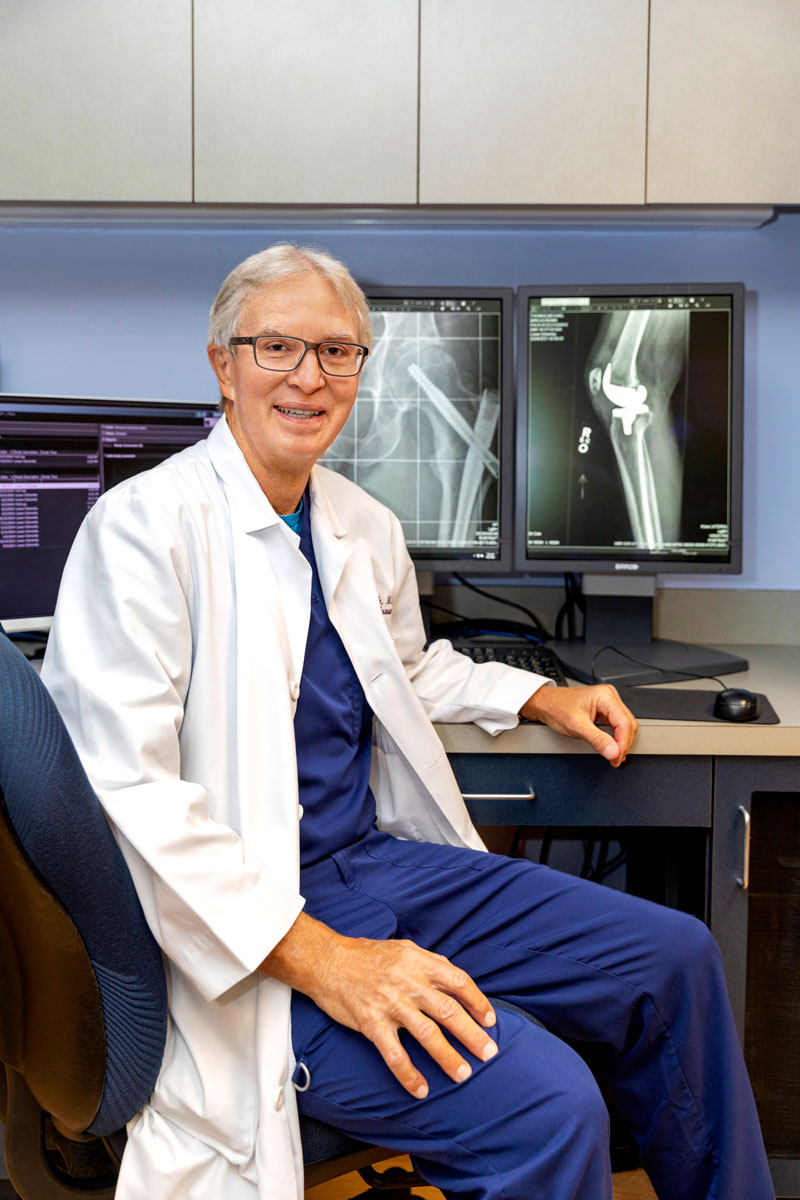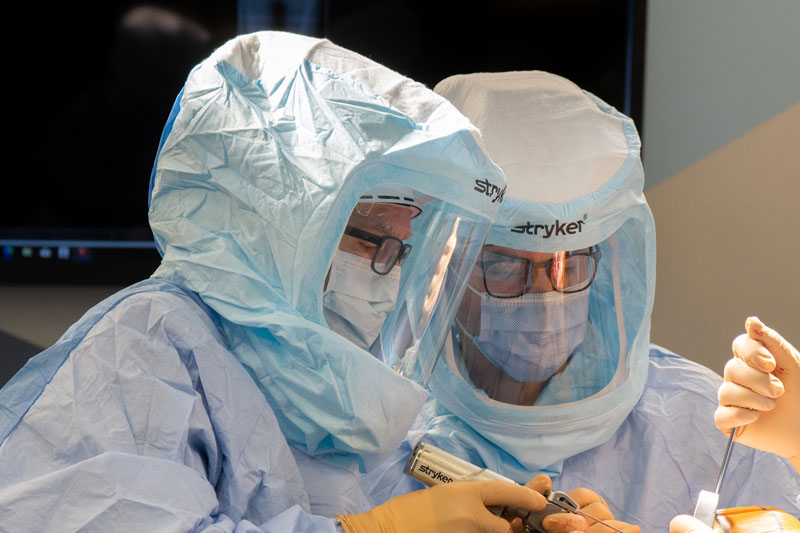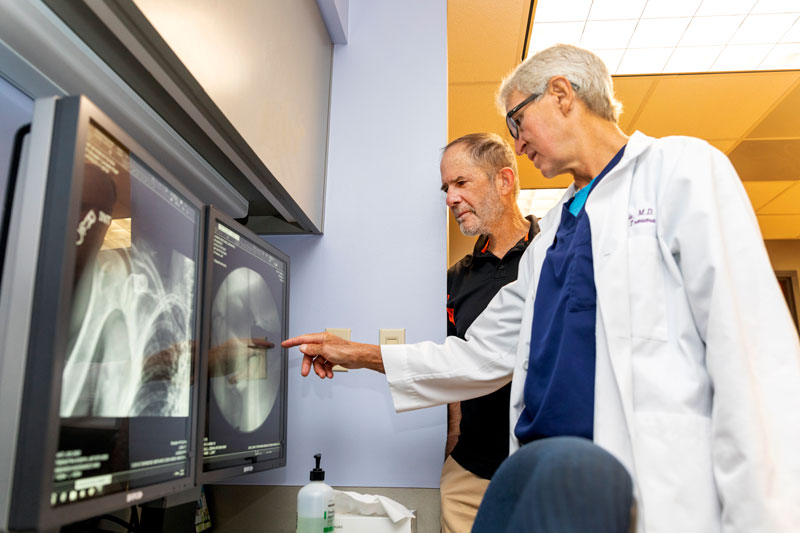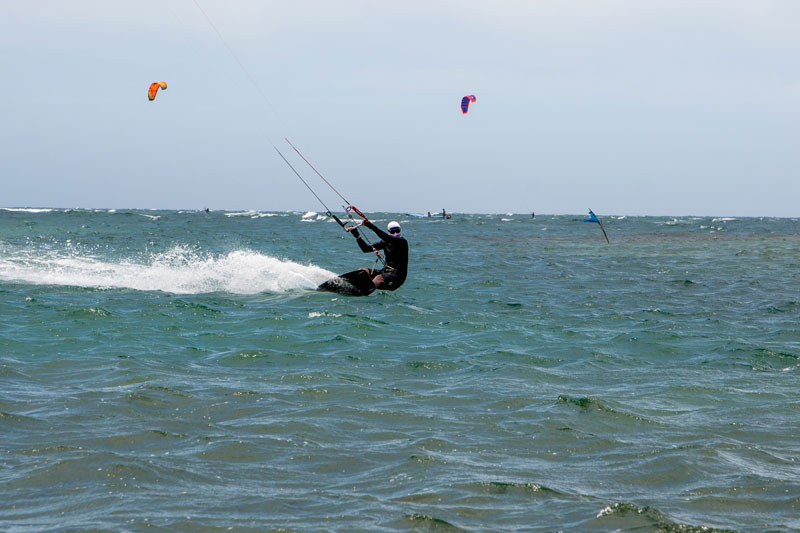
The patient was not wearing a seatbelt when the crash occurred. His femur was in pieces. So was his pelvis. So was his forearm.
Doctors and nurses rushed about the Orlando Regional Medical Center emergency room, issuing orders, wheeling in equipment, assessing damage, setting up X-rays.
I was in the background with my reporter’s notebook, on assignment for Florida magazine, which was delivered with the Sunday edition of the Orlando Sentinel. The subjects of the story were two orthopedic residents. I was with them day and night, going to doctors’ meetings, going on rounds, observing surgeries ranging from hip replacements to shoulder repairs to knee arthroscopes.
This was my first look at the controlled chaos of trauma.
The bedlam of the emergency room soon gave way to the calm and quiet of the operating room. The patient was buried under coverings, only the wounded areas left exposed for scalpel access.
The doc in charge didn’t seem much older than the residents. He was so engaged he didn’t notice me. There wasn’t any of the music or banter I heard in other operating rooms.
A screen was next to the patient. It displayed X-ray images of his broken femur. The surgeon referred to it constantly as he inserted instruments into and out of a small incision. He was lining the bones up for the hardware that would hold them in place.
I recalled when my brother badly broke his femur in a motorcycle accident in the 1970s. The scar extended from his hip to his knee.
This surgeon was, in essence, building a ship in a bottle. He worked all night and into the morning. His name was Dean Cole, a hotshot trauma specialist the likes of which the hospital had never seen. He arrived only a few months earlier from Houston, where he worked at one of the busiest trauma centers in the nation.
And I thought to myself, “If I ever break a bone, I’m going to that guy.”
About 25 years later, I was lying prone on the Cross Seminole Trail, my bike on one side and my friend calling the ambulance on the other.
We were coming down an overpass, when I let off the brakes and picked up speed, oblivious to the sharp left turn ahead. An earlier drizzle left the trail slick, and the tires lost their grip. My bike reared like a horse coming across a rattlesnake and I got tossed.
My left hip absorbed the blow.
I never had a serious crash in all my years of bike racing. It was only when I quit for the sake of safety that the ER trips began. This would be my second. The first was four years prior and involved a somersault over the handlebars that broke six ribs, a collar bone, punctured a lung and dislocated my shoulder.
As before, Seminole County firefighters came to the rescue.
“Got a doctor?” one of them asked.
The name popped into my head.
“Dean Cole,” I said.

–––––––
The X-ray confirmed my hip was broken. Florida Hospital Altamonte shipped me off to Florida Hospital South, where I expected Cole would be operating on me the next morning.
Between now and the time I first saw him in 1989, Cole had become a boneyard legend. He was the surgeon for patients with bones so shattered that other doctors could not repair them.
There were construction workers who had fallen from on high. The endless car and motorcycle crashes. The tugboat worker whose leg was torn apart in an accident and badly infected by the oily water. Cole saved the leg from amputation.
His phone never stopped ringing. Cole worked nonstop, often seven days a week, for up to 15 hours a day. As one of only about 10 orthopedic trauma surgeons in Florida, he saw roughly 1,000 patients a year and was labeled by the Orlando Business Journal as “a physician of last resort for patients throughout the state.”
It was no small matter, then, when Cole affiliated with Florida Hospital (now AdventHealth) in 2004. The hospital created a Fracture Care Center for him to run. He got access to a cadaver lab for his research. He was given guaranteed beds for his patients. He got high-tech equipment in the operating room. Cole brought his entire team with him, a group of highly trained assistants, nurses, and technicians that in size would rival the entourage of an NBA all-star.
I was brought down to pre-op at 5 a.m. for the hip repair. I assumed Cole would be the surgeon, then found out otherwise. And so I refused to go in the operating room.
“He has a full schedule,” a nurse told me.
“I’ll wait,” I replied.
The hospital staff tried several more times, but I wouldn’t budge.
After about 12 hours, a masked face appeared through the curtain. I recognized it from long ago.
“OK,’’ he said. “I’ll fit you in.”
–––––––
Cole pretty much had life figured out early on. He met his future wife, Debbie, in sixth grade. He knew at age 12 that he was going to be a doctor and started studying anatomy in the encyclopedia.
He was a beach kid raised in Mims, in Brevard County, while his dad worked as an engineer at the Kennedy Space Center. He spent his time on the water — surfing, fishing, swimming and even driving a shrimp trawler because he was the best at triangulating positions.
He worked in a boatyard where the owner advised him to forget this doctor stuff and be an electrician. Cole passed the electrician’s exam while in high school, but the goal of being a surgeon had not changed.
“Things became easy at that point because I knew the end point,” he says. “All I had to do was follow the path.”
He attended Titusville and Astronaut high schools, played halfback on their football teams, and opted for Rollins College when offered a scholarship and job as a campus electrician.
“Rollins isn’t known for pre-med,” he says. “But everyone who made it through their program got into medical school. After going there, it made medical school pretty easy. Rollins prepared you how to study. You could tackle problems. There were small classes. The professors knew you and pushed you on what you could handle.
“I looked at it as work and took it seriously.”
The University of South Florida Morsani College of Medicine medical school accepted him into an early admission program after one interview.
While training to be an orthopedic surgeon at USF, Cole was not happy with the surgical tools. And so he tapped into his background as an electrician and began developing his own. His first patent was for an offset drill that could produce more accurate holes in bones. There would be many more to come.
From USF, Cole went to the University of Texas and a traumatology fellowship at the Red Duke Trauma Institute in Houston — one of the busiest in the nation. For five years he worked in the operating room, seeing and doing everything under the best tutelage possible. He became an assistant professor in the Division of Orthopedic Surgery at the University of Texas Medical School.
He returned to Central Florida in 1989, returned to the water and warmth of his childhood.
“I decided I couldn’t live north of Orlando,” he says.

–––––––
Two weeks after my hip surgery, I paid my first visit to Cole’s office. The waiting room looked like Lourdes. Those seeking cures hobbled in on crutches and in wheelchairs, some with mending bones, others with new knees, hips, ankles and shoulders.
Cole, now medical director of the AdventHealth Orlando Orthopedic Institute, had greatly expanded his repertoire from fractures.
After a long wait, I was summoned for X-rays and vital signs. And then Cole appeared in my room. “Hello, Michael.”
He was loose and relaxed — a white doctor’s coat but no tie. His hair was undisciplined. He was lanky and agile, obviously fit and still athletic. He could have slid off a surfboard an hour ago. He sat in front of me — no desk between us — and looked at me intently while talking as if to ensure I didn’t miss a thing.
He said it was a little tricky getting the bones lined up right, as if to validate my intransigence in pre-op.
I pulled out a piece of paper with questions. He smiled at that and answered each one. He was used to explaining things. Then he mentioned something that grabbed my attention — the bone had not started healing yet — not unheard of at two weeks, but still not great.
The bone had not made any progress in subsequent visits. This is called a “nonunion.” Cole’s concern was that the hardware he installed was designed to hold things together temporarily until the healed bones took over the load. I was approaching the design capacity and, at some point, the hardware could fail.
In which case I would likely face more surgery, beefier hardware and some other intervention to stimulate healing. Near panic, I spent days researching nonunions before coming across a drug called Forteo. Designed to strengthen bones of women with osteoporosis, some research showed it could promote fracture healing when used off-label.
I asked Cole about it over the phone, expecting rejection. Instead, I heard, “Hmm, that’s interesting. Do you know about the cancer risk?”
I did and it was acceptable. Cole’s office got me the Forteo, which is injected daily like insulin. I knew the bone hadn’t been healing because of the sharp pain that came from standing on the bad leg. Over the next couple of months, that pain diminished.
An X-ray taken on a visit a couple months later confirmed what I already knew. The bone was healing.
But that was not the last I would see of Cole.
–––––––
My right knee was no longer functioning. Back in 1982, I had intercepted a pass in a sandlot football game, pivoted to reverse direction and collapsed screaming. My anterior cruciate ligament popped.
Back then, to fix such things, surgeons carved through your knee like a Thanksgiving turkey. And then they immobilized the leg for six weeks in a cast, allowing the surgical adhesions to set in like stone.
I couldn’t get my range of motion back. Two different surgeons gave me two different solutions, both involving more cutting. I stopped going to doctors and started running. At first, I hobbled like Quasimodo off to ring the bells. Eventually I wound up in the Boston Marathon trying to break three hours.
After almost 30 years of racing on foot, racing on bikes and backpacking in the mountains, the knee had lived its life. It had become a source of pain and limitation and, as much as the idea terrified me, it had to go. I considered other surgeons — ones who specialized primarily in knee replacements. But I had also kept in touch with Cole, usually through texting, asking him questions about quarterback Tua Tagovailoa’s hip injury or golfer Tiger Woods’ shattered tibia.
I appreciated his obsession with perfection, his acknowledgment of what he didn’t know and his practically nonexistent infection rate. It turned out that he was also fascinated with knees, the way they moved in so many directions, their complexity compared with the hip.
“Knees are cerebral,’’ he told me when describing a hip versus knee replacement. “Hips are all shoulders and back.”
Cole regularly performed knee replacements on cadavers to test out techniques and implants. All of this was impressive, but what really stuck in my mind was the Forteo. He had listened to me. He had given me a voice in my treatment. He had let me try it.
And so, having replaced my hip years before, he replaced my knee last September.
I now am biking up the Clermont hills on 50-mile rides with no pain. I recently hiked the Black Bear Wilderness Trail at a record clip. I paddle board, kayak, fish, lug stuff around — all like I used to do.
But I would not kiteboard.
–––––––
I am at the Orlando Executive Airport, about to get on Cole’s private jet, headed for the Dominican Republic. There’s not a whole lot there except for strong afternoon winds and an offshore reef — the combination of which make it a top kiteboarding destination.
With us is Kevin Healy, a Vero Beach chiropractor who was run over by a Mercedes while riding his bike several months ago. The accident split and fractured his pelvis, tore his muscles apart and damaged the nerves. His innards were a disaster. Cole put him back together. The X-rays practically constitute art. Unfortunately, you can’t fix nerves with hardware and there are lingering issues. But Kevin does pretty well.
The fourth person in our group is the pilot, who once suffered a major tibia fracture in a kiteboarding mishap. Cole fixed him, too. If you play hard, he’s a good friend to have.
Cole’s wife, Debbie, is quite accomplished at water sports but didn’t come along this trip. She runs the office, located on North Orange Avenue. She is very tolerant of his absences.
Arriving at the Dominican airport, we are whisked to a yacht. Cole owns that as well, courtesy of all his inventions and patents — about 25 to date. He doesn’t have to do surgery. He operates because he loves it. His private practice does little more than break even because he is the sole doctor and income-generator.
The jet and yacht are more about time management than luxury and wealth. Cole gets out of surgery after midnight on a Thursday. He is on the plane a few hours later at 6 a.m. The flight takes a little over two hours. The boat ride takes a couple of hours more. The small crew anchors off a beach, lowers the dinghy, loads the gear, and off they go. The entire crew kiteboards.
Cole is a fun boss, a different breed than the usual yacht owner. Nobody calls him Dr. Cole. It’s Dean.
The winds are gusting to more than 30 miles per hour. Portions of the reef stick menacingly out of the water, other corals are dangerously submerged just below the surface. I want no part of getting dragged across sharp coral connected to a runaway kite.
And so, I hike the beach, watching the kiteboarders dart about at warp speed, changing directions, going airborne, performing maneuvers. At age 65, Cole is last to come in.
“He is not human,” says Melanie, one of the crew. “That’s why we love him.”
Cole is a gunslinger at both work and play. The play is a necessary decompression that allows the work to continue. He still puts in 15 hours days in surgery. “I don’t get tired,” he once told me. Now I believe it.
He still is inventing new tools and medical devices. His greatest fear in life seems to be wasting any of it.
I ask him if he ever reflects on the thousands of lives he has impacted.
“No, not really,” he says. “I just move forward.”
I ask him how much longer he is going to do surgery.
He considers the question a second.
“Until I die.”
Mike Thomas, a member of the Maitland City Council, is a former award-winning reporter and columnist for the Orlando Sentinel. He now is an occasional consultant and freelance writer, but spends most of his time cycling, paddle boarding, fishing and being a cross country and track dad at Winter Park High School. He can be reached at mikethomas2420@gmail.com.


